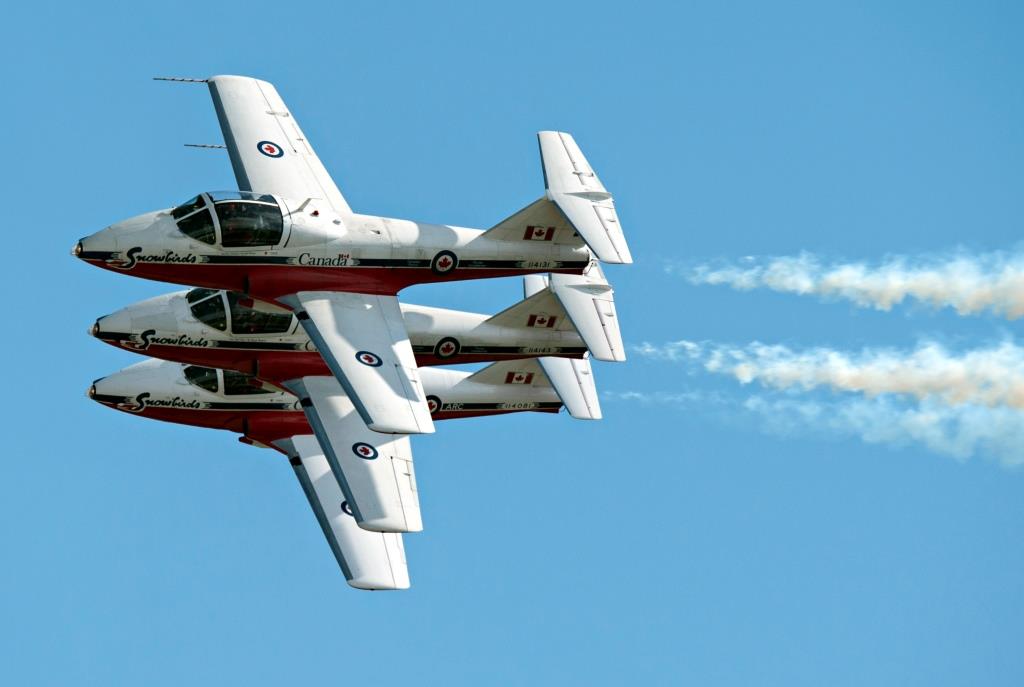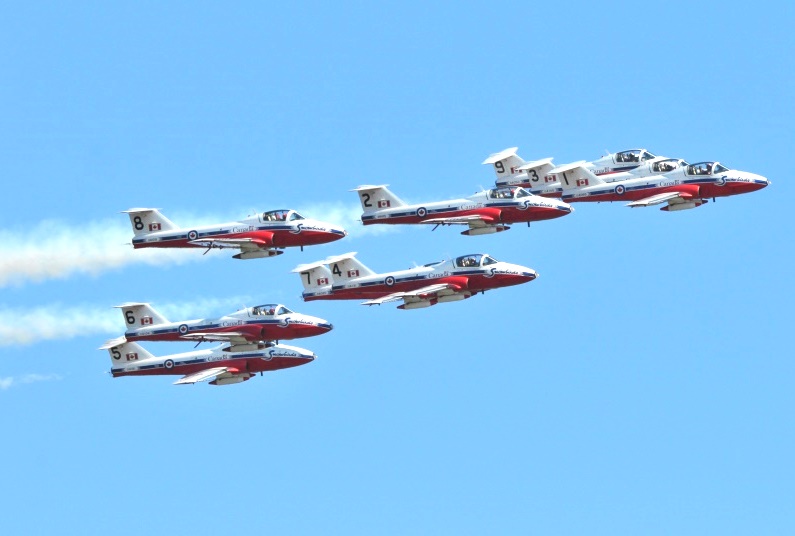SNOWBIRD REPLACEMENT
BY JOETEY ATTARIWALA
To Upgrade or Replace
Canada’s Snowbirds?
 The Snowbirds of 431 Air Demonstration Squadron are a world-renowned aerobatic display team of the Royal Canadian Air Force (RCAF). Unlike most other display teams, the Snowbirds represent the entire Canadian Armed Forces (CAF), not just the RCAF. Team pilots are all members of the RCAF whereas the support staff may be members of the RCAF, Royal Canadian Navy or from the Canadian Army.
The Snowbirds of 431 Air Demonstration Squadron are a world-renowned aerobatic display team of the Royal Canadian Air Force (RCAF). Unlike most other display teams, the Snowbirds represent the entire Canadian Armed Forces (CAF), not just the RCAF. Team pilots are all members of the RCAF whereas the support staff may be members of the RCAF, Royal Canadian Navy or from the Canadian Army.
Every year the Snowbirds crisscross the country and perform to the delight of spectators. The team is iconic and part of the Canadian lexicon, and they also serve as flying ambassadors abroad. The squadron consists of 9 Canadair-built CT-114 Tutor jet trainers plus two spare jets which are always on stand-by should one of the primary jets become unserviceable during air shows. Snowbirds 10 and 11 are flown by the teams Advance and Safety pilots, who also provide the commentary at various show sites.
The maneuvers performed by the Snowbirds require precision flying ability from pilots and that is channeled through their Tutor aircraft which were first acquired in 1963 and have been flying in air demonstrations since 1971. As much as the Snowbirds please spectators young and old, there is no disputing that the Squadron is strained - the last year has been exceptionally difficult in the wake of two crashes, one of which resulted in the tragic loss of a team member.
The Tutor aircraft are meticulously maintained by highly professional technicians, however, one can make an argument that there is a reasonable limit to the amount of time and investment that should be made into an aircraft that has been operating for nearly 50 years.
There is no doubt that investment in the Tutor fleet was much more palatable when the RCAF operated Tutor aircraft in other roles – primarily in training – however, that ended in 2000, and was superseded by contractor-supported CT-156 Harvard II turboprops and the CT-155 Hawk jet trainers, which leaves the Snowbirds as the only Tutor operator in RCAF today.
SNOWBIRDS SAFETY
Flying a high-performance aircraft in aerobatic teams is strenuous and not without risk. All aerobatic teams are dedicated to ensuring their aircraft are in top condition to ensure the most reliable and safe aircraft. Moreover, their pilots are always trained at the highest level.
Sadly, accidents can still happen even with the best maintenance. In total, 7 pilots and 2 other crew have been killed and 17 aircraft have been lost over the course of the Snowbirds' 49-year history. The reasons for these accidents vary however, two points are undisputable: it is increasingly challenging to keep older platforms airworthy and that challenge becomes more expensive with age.
The Canadian military has known since 2016 that the ejection seats on the Snowbird aircraft needed to be upgraded but a program to address this issue was only recently launched. The plan is to go through a parachute upgrade program, which first will identify and assess candidate canopy designs then perform testing for airworthiness clearance and eventually implement a new parachute system in the CT-114.
Other planned investments are to modernize the communications and avionics systems of the aircraft. It is apparent the cost of updating the Snowbirds’ CT-114 is increasing, with cost estimate figures on a DND website predicting the project to be between $50 and $99 million.
Sources tell CDR that a request for proposal to upgrade the Tutor jets could be issued next year. A contract would likely be awarded that same year with the first of the upgraded CT-114 Tutors scheduled to be ready for the Snowbirds in 2022. The project would be finished by 2025 with all upgraded planes delivered with the aim to keep the CT-114 Tutor flying until the year 2030 - around 60 years after the first delivery to the Snowbirds. That translates into a $9 million cost each year for the next 10 years of the remaining life of the Tutors.
A DND website (last updated in 2018 and now archived) detailed a Snowbird Aircraft Replacement Project (SARP) which was linked to the CT-114 Life Extension Beyond 2020 project. According to the website: the SARP may also be linked to the solution for Future Pilot Training, which is due to replace NATO Flying Training in Canada. The chosen platform must be configurable to 431 (AD) Squadron standards, including a smoke system, luggage capability and a unique paint scheme. The platform must also be interchangeable with the training fleet to ensure the demands of show performances can be distributed throughout the aircraft fleet. The preliminary cost estimate for this project was between $500 million and $1.5 billion.
In reality, our research shows that Canada could acquire 15 aircraft to replace the Tutor at a cost of no more than $200-220 million, including spares (depending on aircraft). This equates to a coast of about $7.3 million a year if we consider a conservative operational life of a brand-new jet over 30 years. If a more realistic 40 years is considered, the cost further decreases to $5.5 million per year.
The DND did not mention any technical considerations about potential cost versus benefit of the two options noted above: to spend up to $99 million to keep the Tutor aircraft flying for 10 more years and then launch a replacement program for unknown millions, versus considering an early replacement that could be in service for the next 30-40 years.
DEMONTRATION AIRCRAFT
IN USE AROUND THE WORLD
The federal government has indicated it wants the Snowbirds to continue operating as they are a key public relations tool for the military. This is a sound decision and in line with most nations around the world.
World air forces have adopted different solutions for their aerobatic teams. In most cases aerobatic teams use the same type of aircraft in service with the training squadrons, but this is not a fixed rule. Canada is one of the most notable exceptions in line with the U.S. Air Force (F-16 fighter), U.S. Navy (F/A-18E), Switzerland (F-5 fighter), Russia (Su-30), China (J-10) and Singapore (F-16).
With their speed and dynamic presence in the sky, jets are considered the most prestigious aircraft to demonstrate the air force’s capability. Other important air forces of the world are all flying jet trainers that are in service with their training squadrons: UK, France, Italy, Spain, Poland, Sweden, Finland, South Korea, Saudi Arabia, UAE, Japan, India, Pakistan, Malaysia.
Smaller air forces typically use turboprop or piston engine trainers for their aerobatic teams. However, being slower and less capable of performing formations in vertical maneuvers makes a turboprop or piston aircraft less appealing for aerobatic teams.
REPLACEMENT OPTIONS
There are several turboprop types available on the market that could be a potential candidate to replace the Snowbirds. The most obvious is the CT-156 Harvard II which is already in service with 2 Canadian Forces Flying Training School (2 CFFTS) in Moose Jaw. The CT-156 Harvard II (T-6 Texan II), is a single-engine, two-seat (tandem), basic trainer designed to train students in Phase II and III of training syllabus. The aircraft is fully acrobatic and features a pressurized cockpit with an anti-G system, ejection seat and advanced avionics package with sunlight-readable liquid crystal displays. The PC-9 from which the CT-156 derives, is used by the aerobatic teams of Croatia and Slovenia.
Other turboprop options could be considered such as the Pilatus PC-21, the South Korean KT-1, the Brazilian Super Tucano - all of which are in service with aerobatic teams around the world (Switzerland, Australia, Indonesia, Brazil), but it would make less sense for Canada to buy another type of turboprop when one is already in operation with the RCAF.
Only a few new generation jet trainers of the same class of the CT-114 Tutor are available today.
The Czech Republic Aero Vodochody L-39NG is a major improvement of the L-39 advanced jet trainer which entered service in the 1970s.
The Italian Aermacchi M-345 is the heir of the MB-339 which is the pillar of the Italian Frecce Tricolori and the UAE’s Al Fursan, both of whom are recognized as being among the best aerobatic teams in the world. The M-345 is the latest-generation training platform from Leonardo Aircraft and is branded as the Tutor II due to its close similarity with the CT-114 in terms of performance. It has been chosen by the Italian Air Force as a new jet for the Frecce Tricolori who will start to fly the M-345 in 2023.
Both the L-39NG and the M-345 use the same engine, the efficient Williams FJ-44, and both claim to be very affordable to purchase and maintain in service. For the aerobatic team’s task, being around a ton heavier than the M-345, the L-39NG has less performance capability compared to the Italian jet.
The M-345 also claims to have a similar life-cycle cost and superior overall performance compared to a turboprop trainer in the class of the Pilatus PC-21. Being a jet, the M-345, demonstrates higher Max Level Speed; higher Rate of Climb, and higher Sustained Load Factor at sea level - all of which are parameters that are relevant for any aerobatic display.
One might wonder about the Boeing T-7A, KAI T-50, BAE Systems Hawk, and the Aermacchi M-346. All of these training aircraft are formidable in their own right however, their performance and price is in a higher category than the jets noted in preceding paragraphs which are more in line with the current CT-114.
The Snowbirds are iconic and their value as ambassadors of the CAF and Canada is undisputed. Serious consideration must now take place to determine whether to continue to invest in the CT-114. If maintained, then what upgrades will be required to negate obsolescence or regulatory issues? Does it make sense and is it too costly to do it?
As noted above, great synergy could be realized if the Snowbirds acquisition ties into the Future Fighter Lead-In Trainer however, this project is years ahead and will likely be chosen after Canada chooses its next fighter. There are options to continuing to invest in the Tutor - whether these are embraced or not, only time will tell, but a heartfelt discussion needs to begin today.
Joetey Attariwala is CDR’s Senior Staff Writer & Aviation Editor


